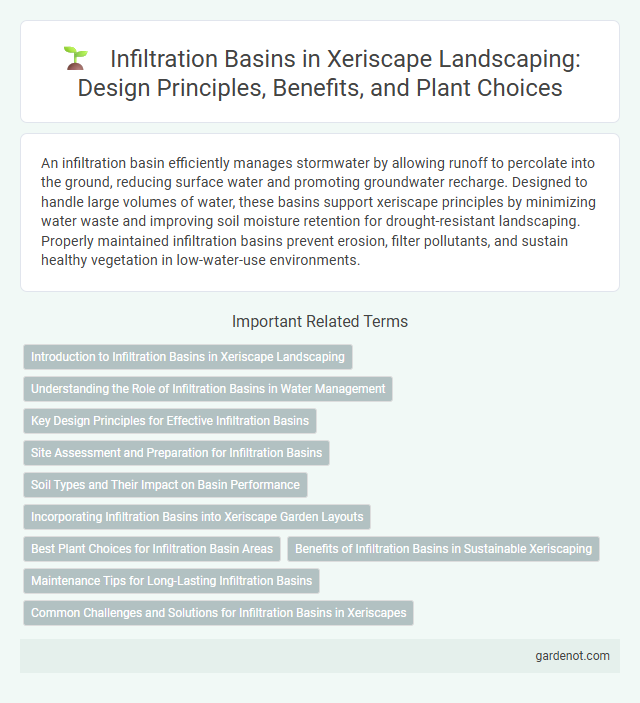An infiltration basin efficiently manages stormwater by allowing runoff to percolate into the ground, reducing surface water and promoting groundwater recharge. Designed to handle large volumes of water, these basins support xeriscape principles by minimizing water waste and improving soil moisture retention for drought-resistant landscaping. Properly maintained infiltration basins prevent erosion, filter pollutants, and sustain healthy vegetation in low-water-use environments.
Introduction to Infiltration Basins in Xeriscape Landscaping
Infiltration basins in xeriscape landscaping serve as essential water management features designed to capture and absorb stormwater runoff, promoting groundwater recharge while reducing erosion and surface runoff. These shallow, vegetated depressions optimize soil infiltration rates by directing excess water into permeable ground, supporting drought-resistant plantings native to arid climates. Integrating infiltration basins enhances landscape sustainability by maintaining soil moisture balance and conserving water resources in xeric environments.
Understanding the Role of Infiltration Basins in Water Management
Infiltration basins play a critical role in xeriscape water management by capturing and slowly releasing stormwater, reducing runoff and promoting groundwater recharge. These basins are designed to maximize water infiltration into the soil, supporting drought-resistant landscaping and minimizing irrigation needs. Incorporating infiltration basins enhances sustainable water use in xeriscaping by balancing water conservation with effective stormwater control.
Key Design Principles for Effective Infiltration Basins
Effective infiltration basins rely on permeable soil with infiltration rates typically between 0.5 to 1.5 inches per hour to maximize water absorption and minimize runoff. Proper basin sizing is critical, often designed to capture the volume of rainfall from a 2-year, 24-hour storm event, ensuring adequate detention time for infiltration. Incorporating vegetation such as native grasses and shrubs stabilizes soil, enhances evapotranspiration, and promotes pollutant removal through natural filtration processes.
Site Assessment and Preparation for Infiltration Basins
Site assessment for infiltration basins involves evaluating soil permeability, topography, and existing drainage patterns to ensure effective water absorption and prevent surface runoff. Proper site preparation includes grading the basin to facilitate water infiltration, removing impermeable layers, and incorporating sediment control measures to maintain basin function. Detailed soil testing and hydrological analysis optimize basin placement, enhancing xeriscape water conservation efforts.
Soil Types and Their Impact on Basin Performance
Infiltration basins designed for xeriscape landscapes depend heavily on soil types, with sandy and loamy soils offering superior permeability for efficient water absorption. Clay-heavy soils impede infiltration, leading to surface runoff and reduced basin effectiveness. Optimizing basin performance requires soil amendments or selection strategies that enhance infiltration rates and support drought-tolerant vegetation.
Incorporating Infiltration Basins into Xeriscape Garden Layouts
Infiltration basins enhance xeriscape garden layouts by efficiently capturing and slowly absorbing stormwater, reducing runoff and promoting groundwater recharge. Strategic placement of these basins within xeriscape designs supports drought-resistant plants by maintaining consistent soil moisture without overwatering. Integrating infiltration basins optimizes water conservation practices while enhancing the ecological function and aesthetic appeal of xeriscape landscapes.
Best Plant Choices for Infiltration Basin Areas
Best plant choices for infiltration basin areas include deep-rooted native grasses like Bouteloua gracilis and Carex species, which enhance soil permeability and water absorption. Sedges and rushes, particularly Juncus effusus, are ideal for wet conditions, stabilizing basin edges while filtering runoff. Incorporating drought-tolerant perennials such as Echinacea purpurea improves basin resilience and supports local biodiversity in xeriscape designs.
Benefits of Infiltration Basins in Sustainable Xeriscaping
Infiltration basins enhance sustainable xeriscaping by effectively capturing and filtering runoff, promoting groundwater recharge, and reducing erosion. These basins support native drought-tolerant plants by maintaining soil moisture without excessive irrigation. Their integration in xeriscaped landscapes optimizes water conservation and improves urban stormwater management.
Maintenance Tips for Long-Lasting Infiltration Basins
Regularly inspect infiltration basins for sediment buildup and remove debris to maintain optimal water absorption and prevent clogging. Incorporate native, drought-tolerant plants to stabilize soil and reduce erosion while minimizing watering needs. Implement seasonal maintenance, including vegetation trimming and soil aeration, to sustain basin functionality and extend its lifespan within a xeriscape landscape.
Common Challenges and Solutions for Infiltration Basins in Xeriscapes
Infiltration basins in xeriscapes often face challenges such as soil clogging, uneven water distribution, and sediment accumulation that reduce infiltration efficiency. Solutions include periodic sediment removal, incorporating pre-treatment filters, and using adaptive planting strategies with drought-tolerant species to stabilize basin soils. Effective maintenance and design modifications enhance water absorption while supporting xeriscape sustainability.
Infiltration basin Infographic

 gardenot.com
gardenot.com